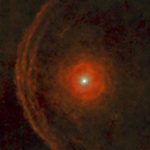Key Takeaways:
- There are likely 40 quintillion (40,000,000,000,000,000,000) stellar-mass black holes, which is 1% of all normal matter in the observable universe.
- Finding black holes is difficult, so scientists developed a new technique to estimate their numbers by modeling how stars evolve and become black holes.
- Stars 5-10 times the sun’s mass are needed to form black holes. Iron fusion in these stars triggers a collapse, leading to a singularity and black hole formation.
- The study considered the formation rates of different sized stars across various galaxies to determine how many would turn into black holes.
- Understanding how many stellar-mass black holes formed might help explain the origin of supermassive black holes, which likely grew from merging smaller ones.
The number of “small” black holes in the universe has been estimated by scientists. And no surprise: It’s a lot.
It may seem impossible to compute this number because, well, finding black holes isn’t exactly the easiest thing to do. Because they’re are as pitch-black as the space they lurk in, the light swallowing cosmic goliaths can be detected only under the most extraordinary circumstances — like when they’re bending the light around them, snacking on the unfortunate gases and stars that stray too close, or spiraling toward enormous collisions that unleash gravitational waves.
However, this hasn’t stopped scientists from coming up with some creative guesses for the number. Astrophysicists have developed a new technique that was published in The Astrophysical Journal to generate an updated estimate for the number of stellar-mass black holes — those with masses 5 to 10 times that of the sun — in the universe.
And it’s astounding: the new estimate states that 40,000,000,000,000,000,000, or 40 quintillion, stellar-mass black holes comprise 1% of all normal matter in the observable universe.
How then did the scientists calculate that figure? According to first author Alex Sicilia, an astrophysicist at the International School of Advanced Studies (SISSA) in Trieste, Italy, the researchers calculated how frequently stars in our universe would become black holes by observing their evolution.
“This is one of the first, and one of the most robust, ab initio [ground up] computation[s] of the stellar black hole mass function across cosmic history,” Sicilia said in a statement.
A large star, roughly 5 to 10 times the mass of the sun, is the necessary for creating a black hole. As big stars reach the end of their lives, they begin to fuse heavier and heavier elements, such as silicon or magnesium, inside their fiery cores. But the star is headed for violent self-destruction as soon as this fusion process begins to generate iron. Iron takes in more energy to fuse than it gives out, causing the star to lose its ability to push out against the immense gravitational forces generated by its enormous mass. It collapses in on itself, packing first its core, and later all the matter close to it, into a point of infinitesimal dimensions and infinite density — a singularity. The star becomes a black hole, and beyond a boundary called the event horizon, nothing — not even light — can escape its gravitational pull.
The astrophysicists modeled both the lives and pre-lives of the stars in the universe to arrive at their estimate. The group created a model of the universe that precisely represented the different sizes of stars that would be made and how frequently they would be created using known statistics of different galaxies, such as their sizes, the elements they contain, and the sizes of the gas clouds stars would form in.
The percentage of candidate stars that would eventually become black holes was determined by demonstrating the lives and deaths of those stars using characteristics like their mass and metallicity, or the abundance of elements heavier than hydrogen or helium. This was done after the researchers had determined the rate at which stars that could eventually become black holes formed. The researchers made sure they weren’t double-counting any black holes in their survey by also examining stars that were paired into binary systems and by figuring out how quickly black holes can collide and merge. They also calculated the effects of these mergers on the distribution of black hole sizes throughout the universe, taking into account the fact that black holes also consume on nearby gas.
With these calculations in hand, the researchers designed a model that tracked the population and size distribution of stellar-mass black holes over time to give them their eye-watering number. The scientists then verified that their model was in good agreement with the data by comparing the estimate with data from gravitational waves, or ripples in space-time, created by black hole and binary star mergers.
The new estimate was created to help astronomers explore some of the perplexing mysteries revealed by observations of the very early universe. For example, how did supermassive black holes, which frequently have masses millions or even billions of times larger than the stellar-mass holes the researchers looked at in this study, populate the early universe so quickly after the Big Bang?
The researchers hope that a better understanding of how small black holes formed in the early universe could help them unearth the origins of their supermassive cousins. This is because these enormous black holes originated from the merging of smaller, stellar-mass black holes, or black hole “seeds.”
According to Lumen Boco, an astrophysicist at SISSA, “Our work provides a robust theory for the generation of light seeds for supermassive black holes at high redshift [further back in time], and can constitute a starting point to investigate the origin of “heavy seeds,” that we will pursue in a forthcoming paper.”


